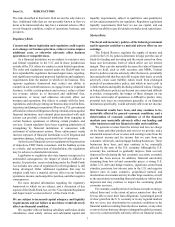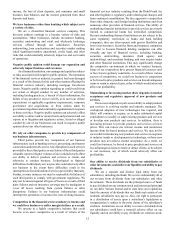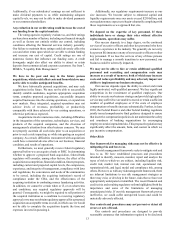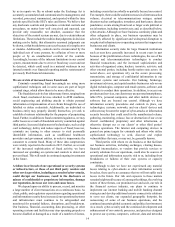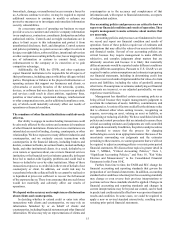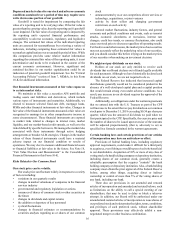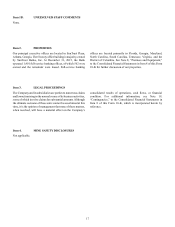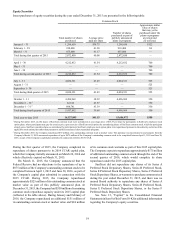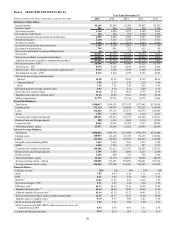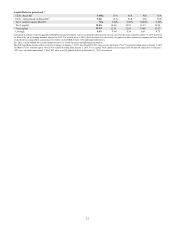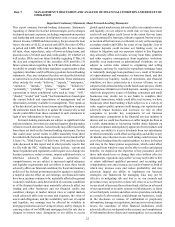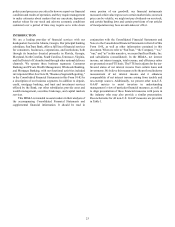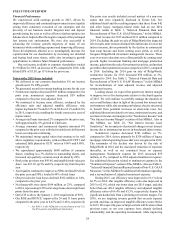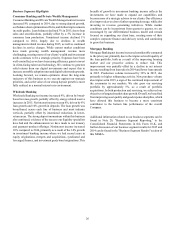SunTrust 2015 Annual Report Download - page 44
Download and view the complete annual report
Please find page 44 of the 2015 SunTrust annual report below. You can navigate through the pages in the report by either clicking on the pages listed below, or by using the keyword search tool below to find specific information within the annual report.16
Depressed market values for our stock and adverse economic
conditions sustained over a period of time may require us to
write down some portion of our goodwill.
Goodwill is tested for impairment by comparing the fair
value of a reporting unit to its carrying value. If the fair value is
greater than the carrying value, then the reporting unit’s goodwill
is not impaired. The fair value of a reporting unit is impacted by
the reporting unit's expected financial performance and
susceptibility to adverse economic, regulatory, and legislative
changes. The estimated fair values of the individual reporting
units are assessed for reasonableness by reviewing a variety of
indicators, including comparing these estimated fair values to
our market capitalization over a reasonable period of time. While
this comparison provides some relative market information
regarding the estimated fair value of the reporting units, it is not
determinative and needs to be evaluated in the context of the
current economic environment. However, significant and
sustained declines in our market capitalization could be an
indication of potential goodwill impairment. See the "Critical
Accounting Policies" section of Item 7, MD&A, in this Form
10-K for additional information.
Our financial instruments measured at fair value expose us
to certain market risks.
We maintain at fair value a securities AFS portfolio and
trading assets and liabilities and derivatives, which include
various types of instruments and maturities. Additionally, we
elected to measure selected fixed-rate debt, mortgage loans,
MSRs and other financial instruments at fair value. Changes in
fair value of the financial instruments measured at fair value are
recognized in earnings (or in other comprehensive income in
some circumstances). These financial instruments are exposed
to market risks related to changes in interest rates, market
liquidity, and our market-based credit spreads, as well as to the
risk of default by specific borrowers. We manage the market risks
associated with these instruments through active hedging
arrangements or broader ALM strategies. Changes in the market
values of these financial instruments could have a material
adverse impact on our financial condition or results of
operations. We may elect to measure additional financial assets
or financial liabilities at fair value in the future. See Note 18,
“Fair Value Election and Measurement" to the Consolidated
Financial Statements in this Form 10-K.
Risks Related to Our Common Stock
Our stock price can be volatile.
Our stock price can fluctuate widely in response to a variety
of factors including:
• variations in our quarterly results
• changes in market valuations of companies in the financial
services industry
• governmental and regulatory legislation or actions
• issuances of shares of common stock or other securities in
the future
• changes in dividends and capital returns
• the addition or departure of key personnel
• cyclical fluctuations
• changes in financial estimates or recommendations by
securities analysts regarding us or shares of our common
stock
• announcements by us or our competitors of new services or
technology, acquisitions, or joint ventures
• activity by short sellers and changing government
restrictions on such activity
General market fluctuations, industry factors, and general
economic and political conditions and events, such as terrorist
attacks, economic slowdowns or recessions, interest rate
changes, credit loss trends, or currency fluctuations, also could
cause our stock price to decrease regardless of operating results.
For the above and other reasons, the market price of our securities
may not accurately reflect the underlying value of our securities,
and you should consider this before relying on the market prices
of our securities when making an investment decision.
We might not pay dividends on our stock.
Holders of our stock are only entitled to receive such
dividends that our Board declares out of funds legally available
for such payments. Although we have historically declared cash
dividends on our stock, we are not required to do so.
The Federal Reserve has indicated that increased capital
distributions generally would not be considered prudent in the
absence of a well-developed capital plan and a capital position
that would remain strong even under adverse conditions. As a
result, any increase in our dividend requires the approval of the
Federal Reserve.
Additionally, our obligations under the warrant agreements
that we entered into with the U.S. Treasury as part of the CPP
will increase to the extent that we pay dividends on our common
stock prior to December 31, 2018 exceeding $0.54 per share per
quarter, which was the amount of dividends we paid when we
first participated in the CPP. Specifically, the exercise price and
the number of shares to be issued upon exercise of the warrants
will be adjusted proportionately (that is, adversely to us) as
specified in a formula contained in the warrant agreements.
Certain banking laws and certain provisions of our articles
of incorporation may have an anti-takeover effect.
Provisions of federal banking laws, including regulatory
approval requirements, could make it difficult for a third party
to acquire us, even if doing so would be perceived to be beneficial
to our shareholders. Acquisition of 10% or more of any class of
voting stock of a bank holding company or depository institution,
including shares of our common stock, generally creates a
rebuttable presumption that the acquirer “controls” the bank
holding company or depository institution. Also, a bank holding
company must obtain the prior approval of the Federal Reserve
before, among other things, acquiring direct or indirect
ownership or control of more than 5% of the voting shares of
any bank, including our bank.
There also are provisions in our amended and restated
articles of incorporation and amended and restated bylaws, such
as limitations on the ability to call a special meeting of our
shareholders, that may be used to delay or block a takeover
attempt. In addition, our Board will be authorized under our
amended and restated articles of incorporation to issue shares of
our preferred stock and to determine the rights, terms, conditions,
and privileges of such preferred stock, without shareholder
approval. These provisions may effectively inhibit a non-
negotiated merger or other business combination.



